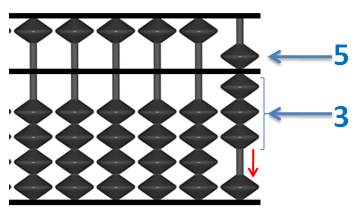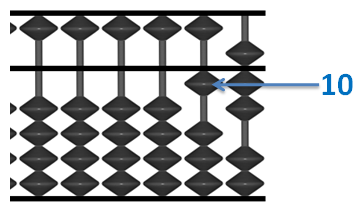How to Calculate Using Japanese Abacus Part 2
In October last year, I have introduced how to represent numbers using the Japanese abacus. In this post, I am going to teach you how to add and subtract using the abacus. If you are not familiar on how to represent numbers using the abacus, please read the first part of this series by clicking the preceding link.

Note that although abacus is not needed in the calculations below since it can be done mentally, calculations done in abacus in real life involve large numbers or even those with decimals. The examples below will only give you an overview of how calculations are made and some of the strategies used.
Example 1: 3 + 4
We cannot add 3 + 4 directly, so we move the three 1-unit counters up and the 5-unit counter down in the ones place to represent 3 + 5. Since we added 5 instead of 4, we return one 1-unit counter down (indicated by the red arrow).
This gives a final answer of two 1-unit counters and one 5-unit counter which equivalent to 3 + 4 = 7.
Example 2: 6 – 3
First, move the 5-unit counter down in the ones place and one 1-unit counter up in the ones place to represent 6. We cannot subtract 3 directly, so we subtract 5 by returning the 5-unit counter and then add two by moving 1-unit counters up. This gives a final answer of three 1-unit counters which mean that the answer is 3.
Example 3: 7 + 6
We represent 7 by moving one 5-unit counter and two 1-unit counters. We cannot add 6 directly, but we can add 10 and then subtract 4. So, we add 1-unit counter in the tens place as shown in the next figure.
The next problem is we cannot subtract 4 directly. So, we can subtract 5 and then add 1. So, we return the 5-unit counter and then move up one 1-unit counter.
Example 4: Subtract 13 – 6
We represent 13 by moving one 1-unit counter in the tens place and three 1-unit counters in the ones place. We cannot subtract 6 directly, but we can subtract 10 and then return 4. So, we subtract 10. Next, we cannot add 4 directly, so we add 5, then return 1.
Credits: The images in this post were taken from the Mr.Giorgio Arcidiacono Online Virtual Abacus.
Reference: Study with Your Friends Mathematics for Elementary School (Gakkohtosho)

